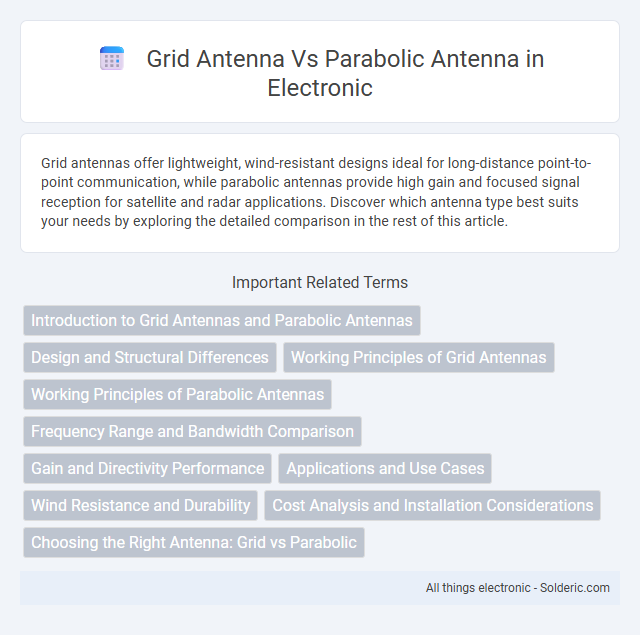Grid antennas offer lightweight, wind-resistant designs ideal for long-distance point-to-point communication, while parabolic antennas provide high gain and focused signal reception for satellite and radar applications. Discover which antenna type best suits your needs by exploring the detailed comparison in the rest of this article.
Comparison Table
| Feature | Grid Antenna | Parabolic Antenna |
|---|---|---|
| Design | Open mesh grid reflector | Solid parabolic dish reflector |
| Frequency Range | Typically 2 GHz to 5 GHz | Wide range, commonly 1 GHz to 40 GHz |
| Gain | Moderate gain (18-25 dBi) | High gain (up to 30+ dBi) |
| Beamwidth | Wide beamwidth | Narrow beamwidth |
| Wind Resistance | High wind resistance due to open structure | Lower wind resistance, more surface area affected |
| Size & Weight | Lighter and less bulky | Heavier and bulkier |
| Best Use | Long-distance directional links with moderate gain | High precision point-to-point communication |
| Cost | Generally lower cost | Higher cost due to material and precision |
Introduction to Grid Antennas and Parabolic Antennas
Grid antennas feature a mesh-like reflector design that reduces wind resistance while maintaining signal strength, ideal for long-distance wireless communication. Parabolic antennas use a solid dish reflector to focus radio waves into a narrow beam, providing high gain and superior signal quality for satellite and point-to-point links. Your choice between these antennas depends on factors like environmental conditions, required signal gain, and alignment precision.
Design and Structural Differences
Grid antennas feature a lightweight, open-framework design composed of parallel metal rods, allowing wind to pass through and reducing wind resistance, making them ideal for outdoor wireless communication. Parabolic antennas utilize a solid, curved reflector dish that concentrates radio waves onto a central feed, providing higher gain and precise signal focus but with increased weight and wind load. The structural materials and shape differences directly impact performance, installation complexity, and suitability for various radio frequency applications.
Working Principles of Grid Antennas
Grid antennas operate by using a series of parallel conductive rods arranged in a grid pattern to focus radio waves onto a central feed element, effectively reducing wind load and improving directional gain. This design allows electromagnetic waves to pass through the grid, reflecting only those aligned with the antenna's polarization, which enhances signal reception and transmission efficiency. You benefit from their lightweight structure and superior performance in long-distance wireless communication where precise targeting and minimal signal loss are critical.
Working Principles of Parabolic Antennas
Parabolic antennas operate by reflecting radio waves off a curved parabolic reflector, focusing the signals onto a central feed antenna to achieve high directional gain. This design allows the antenna to concentrate energy into a narrow beam, enhancing signal strength and reducing interference from other directions. Your communication system benefits from this precise focus, making parabolic antennas ideal for long-distance point-to-point links and satellite communications.
Frequency Range and Bandwidth Comparison
Grid antennas typically operate efficiently within the 2 GHz to 6 GHz frequency range, offering moderate bandwidth suitable for long-distance point-to-point communication. Parabolic antennas support a broader frequency spectrum, from around 1 GHz up to 40 GHz or higher, providing wider bandwidth capabilities ideal for high-frequency satellite and radar applications. The narrower bandwidth of grid antennas limits their versatility, whereas parabolic antennas deliver superior frequency range adaptability for diverse wireless communication needs.
Gain and Directivity Performance
Grid antennas typically offer moderate gain and directivity, ranging between 13 to 20 dBi, making them suitable for medium-range applications with some resistance to wind load due to their open structure. Parabolic antennas provide higher gain and superior directivity, often exceeding 30 dBi, which enables long-distance signal focusing and enhanced performance in point-to-point communication systems. The parabolic design's ability to concentrate electromagnetic waves on a focal point results in narrower beamwidth and reduced signal dispersion compared to the broader beamwidth of grid antennas.
Applications and Use Cases
Grid antennas excel in long-range point-to-point wireless communication, often used in rural internet service and directional Wi-Fi links due to their high gain and resistance to wind load. Parabolic antennas find extensive use in satellite communications, radio telescopes, and radar systems where precise signal focusing and high frequency reception are critical. Your choice between these antennas depends on specific application needs, such as terrain, frequency range, and signal directionality.
Wind Resistance and Durability
Grid antennas offer superior wind resistance due to their open-frame design, allowing wind to pass through and reducing pressure on mounting structures. Parabolic antennas, with their solid dish surfaces, experience higher wind load, making them more vulnerable to damage or misalignment in strong winds. Your choice should consider environmental factors, as grid antennas typically provide enhanced durability in windy conditions.
Cost Analysis and Installation Considerations
Grid antennas typically offer a lower cost solution compared to parabolic antennas due to their simpler design and materials. Installation of grid antennas is generally easier and faster, requiring less precise alignment and smaller mounting structures, which can reduce labor costs. Your choice between the two should consider both budget constraints and the intended application to balance performance with practical installation needs.
Choosing the Right Antenna: Grid vs Parabolic
Grid antennas excel in environments requiring high gain with reduced wind resistance, making them ideal for long-distance point-to-point communications in urban or windy areas. Parabolic antennas offer superior signal focus and higher gain, suited for long-range applications demanding precise alignment and minimal signal loss, such as satellite and radar systems. Selecting between grid and parabolic antennas depends on factors like environmental conditions, required gain, size constraints, and application-specific performance needs.
grid antenna vs parabolic antenna Infographic

 solderic.com
solderic.com